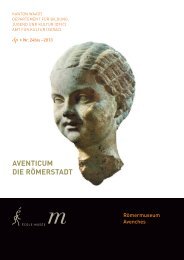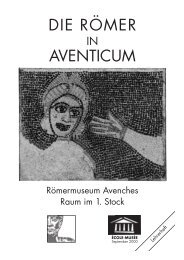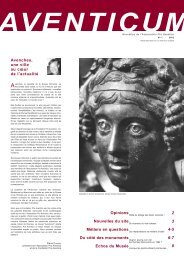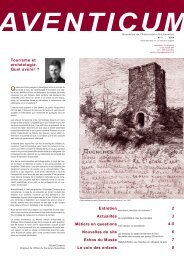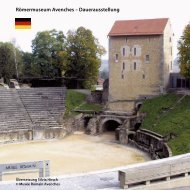Avenches – Roman Museum – Permanent Exhibition
Avenches – Roman Museum – Permanent Exhibition
Avenches – Roman Museum – Permanent Exhibition
You also want an ePaper? Increase the reach of your titles
YUMPU automatically turns print PDFs into web optimized ePapers that Google loves.
First Floor Language and Writing<br />
No inscriptions in Gaulish have been discovered in Aventicum. From time to time,<br />
Celtic names are found, written in a mixture of Greek and Latin alphabets (display<br />
case 6, no.9, display case 23, no. 1). It can be assumed that, from the 1st century<br />
AD onwards, the inhabitants of Aventicum understood Latin. This is confirmed by<br />
funerary, honorific and votive inscriptions dating from this period as well as graffiti<br />
carved on various types of surfaces.<br />
They used a stylus (stilus) for writing (display case 6, nos. 19-21) which had one<br />
sharp end for incising the letters into a wax-covered wooden tablet. The other end<br />
was spatula-shaped so that the text could be erased by smoothing out the wax.<br />
Several tablets could be tied together with a string (display case 6, no. 18).<br />
For writing on papyrus or parchment they used a calamus or quill with a<br />
sharpened point, which was dipped into an inkwell (atramentarium). The latter<br />
could be made of glass (display case 6, no. 10), pottery (display case 6, no. 11) or<br />
bronze. The ink was diluted with water before its use and was either derived from<br />
cuttlefish, from lees of wine or consisted of a mixture of soot and resin.<br />
A book (volumen) consisted of several pages of papyrus or parchment glued<br />
together, which were then rolled onto a wooden stick (display case 6, no. 1).<br />
Capital letters were used for inscriptions on stone and for hallmarks on mortars<br />
(display case 6, no. 8), vases (display case 6, no. 9), amphorae, tiles, and also on various<br />
metal objects.<br />
Engraved (display case 6, nos. 2-3) or painted inscriptions (display case 6, nos. 4-<br />
5) were generally written in italics (small letters); the same applied to everyday<br />
correspondence. Occasionally graffiti were written in capital letters (display case 6,<br />
nos. 6-7).<br />
Seal-boxes (display case 6, nos. 12-16) served as protection for seals used for<br />
closing up writing tablets or parcels. In order to seal something, the intaglioengraved<br />
signet ring was pressed into wax (display case 6, no. 17).<br />
Display case 6<br />
1. Marble statue of a sitting philosopher or poet holding a volumen in his left hand.<br />
2. Fragment of a grey ceramic storage vessel bearing the inscription, in italics, ...icco<br />
immallobrocus, the meaning of which is not clear.<br />
3. Majuscule inscription on painted wall plaster.<br />
4. Neck of amphora (1st century AD) with painted inscription indicating its contents (1):<br />
Excel(lens) / flos... « Excellent flower » ... (referring to the quality of garum, a sauce<br />
containing pieces of fish pickled in salt).<br />
5. Amphora neck bearing a painted inscription indicating its capacity (LXX probably<br />
70 <strong>Roman</strong> pounds or the equivalent of approximately 32.8 litres) as well as the merchant’s<br />
name in genitive case: Felicionis (Felicio). 2nd century AD.<br />
6. Jug fragments (2) with a graffito in capital letters:<br />
LAGO(NA) NICOMIIDIIS QVI ILLA IIMIIRIT<br />
« The (wine)jug of Nicomedes who really deserves it »<br />
1<br />
2<br />
24<br />
First Floor<br />
6



